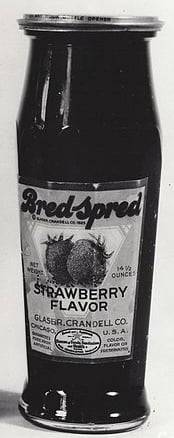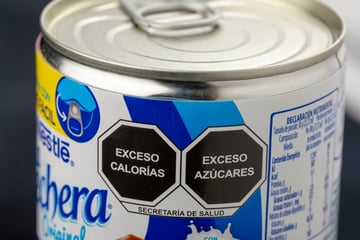Genesis R&D® Foods turns 30 this year, just one year after the same milestone for the Nutrition Labeling and Education Act of 1990 (NLEA). This is not a coincidence.
In fact, ESHA Research introduced Genesis R&D in 1991 to help manufacturers comply with the NLEA, which codified nutrition labeling. For the first time, the NLEA mandated nutrition labels on packaged foods and standardized the layout, serving sizes, and allowable health or nutrition claims.
Evolution of Genesis R&D
Before the NLEA was introduced, ESHA Research had already released a nutrition analysis software with an integrated food and ingredient database, the popular Food Processor. Many food manufacturers, it turned out, were trying to use Food Processor to calculate the nutritional analysis of their recipe for food labels.
During a tradeshow, some of these manufacturers approached ESHA, asking for additional features and specific industry ingredients in order to be able to build their labels correctly.
ESHA thoroughly researched and reviewed NLEA laws and the FDA regulations and concluded that, instead, an entirely new software program was warranted. Thus, Genesis R&D was born. Genesis R&D was the first software program able to deliver the full required nutrition analysis and generate a Nutrition Facts label.
ESHA Research was established in 1981 by Elizabeth S. Hands and Associates. Hands had been looking into the connection between nutrition and her mother’s health issues, and discovered an alarming lack of information, so she began compiling her own data. When researchers and academics took interest in the database, Robert Geltz, her husband and ESHA’s co-founder, used his then-nascent programming skills to manage the data and create a software program to make the data useable to others.
At that time, however, the FDA was wary of allowing computer analysis as an accepted method for nutrition label data.

Food industry scientists were just starting to use computers and most nutrition analysis was still done through labs. So ESHA, through a series of meetings, set out to show the FDA that computerized analysis using a database was just as accurate as lab analysis.
The FDA often performed more than one lab test on a product and averaged the results to compare to the package label. ESHA demonstrated that its database also used average values from a wide variety of sources. After comparing the results of lab vs. database analysis, the FDA concurred that computerized database analysis was indeed accurate.
And they wanted to see more.
“Initially the FDA had few computers but that was changing rapidly. They were very interested and wanted to see what they were likely to encounter when they visited food companies, who were starting to adopt computer technology. Eventually, the FDA bought Genesis R&D to get an idea of what results they might expect during their inspections. Soon, the agency was holding workshops about labeling that included discussions about new software advances, and we were invited to present what Genesis R&D software could do.
Elizabeth S Hands, founder and former CEO of ESHA Research
Now, Final FDA guidance allows the use of databases as an accepted method for developing nutrition labels.
The growth of Genesis R&D has always been in tandem with the growth of the NLEA. Every time the regulations are amended, or a new provision is added, Genesis R&D reflects the change.
Most recently, as the FDA was revamping the Nutrition Facts Panel, ESHA monitored every modification. Less than two months after the final regulations were published, Genesis R&D was updated with the new Nutrition Facts Label layout and nutrient requirements.
In 2016, responding to customer and industry requests, ESHA developed an offshoot of Genesis R&D to specifically address the needs of the supplement manufacturing industry — Genesis R&D Supplement Formulation & Labeling Software.
So, the history of Genesis R&D is, essentially, the history of nutrition and supplement labeling. And they both go much further back than three decades.
History Leading Up to the NLEA
Before 1990, provisions in the Food, Drug, and Cosmetic Act (FD&C Act) of 1938 regulated the labeling of foods. The mandatory nutrition labeling of packaged foods was primarily limited to foods making nutrition claims or foods fortified with vitamins, minerals, or protein.
The FD&C Act of 1938 itself was the FDA’s answer to public outcry over the shortcomings of the first food consumer safety laws — the 1906 Pure Food and Drugs Act (PFDA).
The 1906 act was passed to prevent “…the Manufacture, Sale, or Transportation of Adulterated or Misbranded or Poisonous or Deleterious Foods, Drugs, Medicines, and Liquors, and for Regulating Traffic Therein, and for Other Purposes,” but it soon proved to be woefully inadequate in preventing poisoning, or even death. For example, manufacturers were still legally able to sell attractively packaged and widely advertised products like “BRED-SPRED,” (made of coal tar, artificial pectin, artificial flavors, and grass seeds) sold as food.
To fix the issues in the PFDA, the FDA in 1933 submitted a complete revision. However, it wasn’t until 5 years later, after over 100 people died from using a new therapeutic “wonder drug” called Elixir Sulfanilamide, that the FD&C Act of 1938 was finally signed into law.

It took 52 more years to get to 1990’s NLEA and 83 years to get to where we are now. Let’s take a look at some of the regulatory highlights.
Timeline: History of Food Labeling Laws
Between 1879 and 2016, nearly 100 bills regulating the sale of food and drugs have been introduced in Congress.
1862
Bureau of Chemistry
President Lincoln appointed a chemist, Charles M. Wetherill, to serve in the new Department of Agriculture. This was the beginning of the Bureau of Chemistry, the predecessor of the Food and Drug Administration.
1862
1906
Pure Food and Drugs Act of 1906
On June 30, 1906, President Theodore Roosevelt signed both the Pure Food and Drugs Act (PFDA) and the Meat Inspection Act, which prohibited the sale of adulterated or misbranded livestock.
1906
1907
Board of Food and Drug Inspection Established
The Bureau of Chemistry was charged with administering the PFDA and Secretary of Agriculture James Wilson established the Board of Food and Drug Inspection to develop policy for enforcing the law.
1907
1913
Gould Amendment Passed
The Gould Amendment required that contents of food packages be “plainly and conspicuously marked on the outside of the package in terms of weight, measure, or numerical count."
1913
1927
Food, Drug, and Insecticide Administration
The Bureau of Chemistry was reorganized and the Food, Drug, and Insecticide Administration was born.
1927
1930
McNary-Mapes Amendment Passed
This amendment authorized standards of quality, condition, and/or fill-of-container for most heat-sterilized, hermetically sealed canned foods. The name of Food, Drug, and Insecticide Administration changed to the Food and Drug Administration (FDA).
1930
1933
FDA Initiates a Revision of the Obsolete PFDA
FDA started the process of modernizing the 1906 Pure Food and Drugs Act, which, due to a lack of a pre-market approval system, allowed for the sale of deceptive and dangerous foods, cosmetic ingredients, and medicines. The agency wanted more protection for consumers.
1933
1938
Food, Drug, and Cosmetic Act of 1938
Congress passed the FDCA, which, among its other provisions, gave the FDA authority to issue food standards in "the interest of consumers."
1938
1939
First Food Standards Issued
The First Food Standards to be issued under the 1938 act were for canned tomato, tomato purée, and tomato paste. By the 1960s about half of the food supply was subject to a standard.
1939
1949
First Guidance for Industry
The FDA published its first “guidance to industry: — "Procedures for the Appraisal of the Toxicity of Chemicals in Food.”
1949
1958
Food Additives Amendment Passed
The Food Additives Amendment of 1958 was enacted and required manufacturers of new food additives to establish their safety to FDA's satisfaction before marketing.
1958
1958
GRAS List
FDA published its first list of substances generally recognized as safe (GRAS), which contained nearly 200 substances including ascorbic acid, papain, and propylene glycol.
1958
1906
Color Additive Amendment Passed
The Color Additive Amendment was passed, providing a definition for "color additive" and requiring manufacturers to establish the safety of color additives prior to their use in products. (At the time, about 200 color additives were in commercial use.)
1906
1966
Fair Packaging and Labeling Act of 1966
The Fair Packaging and Labeling Act required all consumer products in interstate commerce to be honestly and informatively labeled, with FDA enforcing provisions on foods, drugs, cosmetics, and medical devices.
1966
1973
FDA Published Final Rule for Voluntary Labeling
Final rules for voluntary nutrition labeling of packaged foods (except mandatory when nutrient claims are made, or nutrients added) and U.S. Recommended Daily Allowances (U.S. RDAs) to be used as a reference standard.
1973
1980
Infant Formula Act of 1980
Congress passed the Infant Formula Act of 1980, which updated the safety standards for formula.
1980
1981
ESHA Research
ESHA Research, named for its founders Elizabeth Stewart Hands and Associates, was established with the goal of providing a comprehensive nutrition database with few missing values.
1981
1984
Food Processor Introduced
ESHA introduced the Food Processor nutriiton and fitness software.
1984
1988
Food and Drug Administration Act of 1988
Food and Drug Administration Act of 1988 officially established the FDA as an agency of the Department of Health and Human Services
1988
1990
Nutrition Labeling and Education Act of 1990
The Nutrition Labeling and Education Act of 1990 (NLEA) is made law. The NLEA required all packaged foods to bear nutrition labeling and all health claims for foods to be consistent with terms defined by the Secretary of Health and Human Services. The food ingredient panel, serving sizes, and terms such as "low fat" and "light" are standardized.
1990
1991
FDA Proposes 26 Rules
The FDA proposed 26 new food label regulations to implement the NLEA.
1991
1991
Genesis R&D Introduced
Genesis R&D Foods was introduced with nutrition analysis and labeling capabilities.
1991
1993
Final Labeling Rules
The FDA published several final rules for the Nutrition Facts panel. They mandated nutrition labeling in a specific format on most packaged foods; established Reference Daily Intakes RDIs) and Daily Reference Values (DRVs) to be used for declaring nutrient content of food; defined serving sizes for 139 food categories; and outlined parameters for using content claims.
1993
1994
Nutrition Facts Panels Required
May 8, 1994, marked the effective date for most food-product packaging provisions of the NLEA, including mandatory nutrition labeling.
1994
1994
Dietary Supplement Health and Education of 1994
Dietary Supplement Health and Education Act (DSHEA) established specific labeling requirements and definitions for dietary supplements, including classifying them as food.
1994
2003
Final Rule Requiring Declaration of Trans Fatty Acids
The FDA published a final rule requiring the addition of
trans fatty acids to nutrition labels. This marked the first substantive change to the Nutrition Facts Panel since 1993.
2003
2004
Food Allergy Labeling and Consumer Protection Act of 2004
The new Food Allergy Labeling and Consumer Protection Act (FALCPA) required the labeling of 8 allergens: peanuts, soybeans, cow's milk, eggs, fish, crustacean shellfish, tree nuts, and wheat.
2004
2014
Food Labeling: Revision of the Nutrition and Supplement Facts Labels Proposed Rule
On Feb. 27, 2014, the FDA announced proposed updates to the labeling regulations for foods and dietary supplements, which Michelle Obama unveiled on the anniversary of her Let’s Move program.
2014
2016
Food Labeling: Revision of the Nutrition and Supplement Facts Labels Final Rule
After several revisions to the proposed rule, the FDA published a final rule "Food Labeling: Revision of the Nutrition and Supplement Facts Labels," on May 27, 2016. The final rule included several amendments including a redesigned Nutrition Facts label.
2016
2016
Genesis R&D Incorporates Updated Nutrition Facts Labels
In July of 2016, just two months after the FDA published its final rule, Genesis R&D was updated with the new Nutrition Facts and Supplement Facts label formats.
2016
2021
Genesis R&D Celebrates its 30th Birthday!
2021
Tag(s):
Food Labeling
Other posts you might be interested in
View All Posts
Product Formulation
4 min read
| July 26, 2021
How Carbs Are Calculated in Different Countries
Read More
Industry Regulations
12 min read
| February 27, 2023
Genesis Foods 11.13: Mexico and Canada Food Label Enhancements Released
Read More
Food Labeling
3 min read
| May 23, 2018

